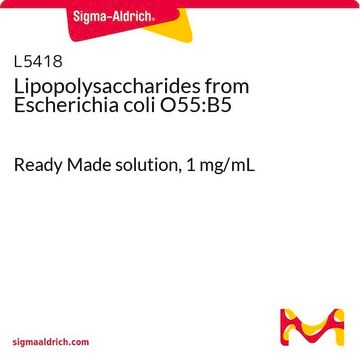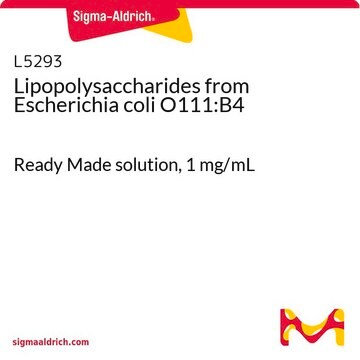L9023
Lipopolysaccharides from Escherichia coli O55:B5
Detoxified
Synonym(s):
LPS
Sign Into View Organizational & Contract Pricing
All Photos(1)
About This Item
Recommended Products
biological source
Escherichia coli (O55:B5)
Quality Level
form
lyophilized powder
shipped in
ambient
storage temp.
2-8°C
Looking for similar products? Visit Product Comparison Guide
General description
This product is extracted from E. coli serotype O55:B5 and purified by chromatography. The source strain is CDC 1644-70. The lipid A moiety has been partially delipidated by alkaline hydrolysis. Removal of the fatty acid portions of lipid A results in a detoxified LPS with an endotoxin level about 10,000 times lower than that of the parent LPS.
Application
Lipopolysaccharides (LPSs) are characteristic components of the cell wall of Gram-negative bacteria. LPS and its lipid A moiety stimulate cells of the innate immune system by the Toll-like receptor 4 (TLR4), a member of the Toll-like receptor protein family, which recognizes common pathogen-associated molecular-patterns (PAMPs).
Biochem/physiol Actions
Lipopolysaccharides (LPS) are localized in the outer layer of the membrane and are, in noncapsulated strains, exposed on the cell surface. They contribute to the integrity of the outer membrane, and protect the cell against the action of bile salts and lipophilic antibiotics.
Preparation Note
Chromatographically purified; delipidized by alkaline hydrolysis
The product is soluble in water (5 mg/ml) or cell culture medium (1 mg/ml) yielding a hazy, faint yellow solution. A more concentrated, though still hazy, solution (20 mg/ml) has been achieved in aqueous saline after vortexing and warming to 70-80 oC. Lipopolysaccharides are molecules that form micelles in every solvent. Hazy solutions are observed in water and phosphate buffered saline. Organic solvents do not give clearer solutions. Methanol yields a turbid suspension with floaters, while water yields a homogeneously hazy solution.
The product is soluble in water (5 mg/ml) or cell culture medium (1 mg/ml) yielding a hazy, faint yellow solution. A more concentrated, though still hazy, solution (20 mg/ml) has been achieved in aqueous saline after vortexing and warming to 70-80 oC. Lipopolysaccharides are molecules that form micelles in every solvent. Hazy solutions are observed in water and phosphate buffered saline. Organic solvents do not give clearer solutions. Methanol yields a turbid suspension with floaters, while water yields a homogeneously hazy solution.
signalword
Danger
hcodes
Hazard Classifications
Acute Tox. 2 Oral
Storage Class
6.1A - Combustible acute toxic Cat. 1 and 2 / very toxic hazardous materials
wgk_germany
WGK 3
flash_point_f
Not applicable
flash_point_c
Not applicable
ppe
Eyeshields, Gloves, type N95 (US)
Choose from one of the most recent versions:
Already Own This Product?
Find documentation for the products that you have recently purchased in the Document Library.
Customers Also Viewed
Ding, H.F., et al.
Journal of Medical Microbiology, 31, 93-93 (1990)
Suhas G Kallapur et al.
American journal of respiratory and critical care medicine, 179(10), 955-961 (2009-02-24)
Chorioamnionitis frequently associates with preterm delivery and increased amniotic fluid IL-1, and causes fetal lung and systemic inflammation. However, chorioamnionitis is also associated with a paradoxical reduction in the incidence of surfactant deficiency-related respiratory distress syndrome in preterm infants. To
Sebastian E Winter et al.
Infection and immunity, 77(5), 1904-1916 (2009-02-25)
Salmonella enterica serotype Typhimurium causes acute inflammatory diarrhea in humans. Flagella contribute to intestinal inflammation, but the mechanism remains unclear since most mutations abrogating pattern recognition of flagellin also prevent motility and reduce bacterial invasion. To determine the contribution of
S E Sivinski et al.
Journal of animal science and biotechnology, 11, 89-89 (2020-09-05)
While feed components capable of modulating the immune system are highly sought after and marketed, often little evidence is available to support functional immune response claims. Thus, a high-throughput in vitro cell screening system was developed to test these compounds
G Tumurkhuu et al.
Clinical and experimental immunology, 152(1), 182-191 (2008-03-01)
The mechanism underlying acute lung injury in lethal endotoxic shock induced by administration of lipopolysaccharide (LPS) into alpha-galactosylceramide (alpha-GalCer)-sensitized mice was studied. Sensitization with alpha-GalCer resulted in the increase of natural killer T (NK T) cells and the production of
Our team of scientists has experience in all areas of research including Life Science, Material Science, Chemical Synthesis, Chromatography, Analytical and many others.
Contact Technical Service




